British Gas Financial Analysis: Ratios, Performance & Insights
VerifiedAdded on 2023/06/14
|16
|2890
|155
Report
AI Summary
This report provides a comprehensive financial analysis of British Gas, a leading energy and home services business in the UK, covering the period from 2018 to 2020. It begins with an introduction to the UK energy market and British Gas's background, followed by a qualitative analysis of the firm's...
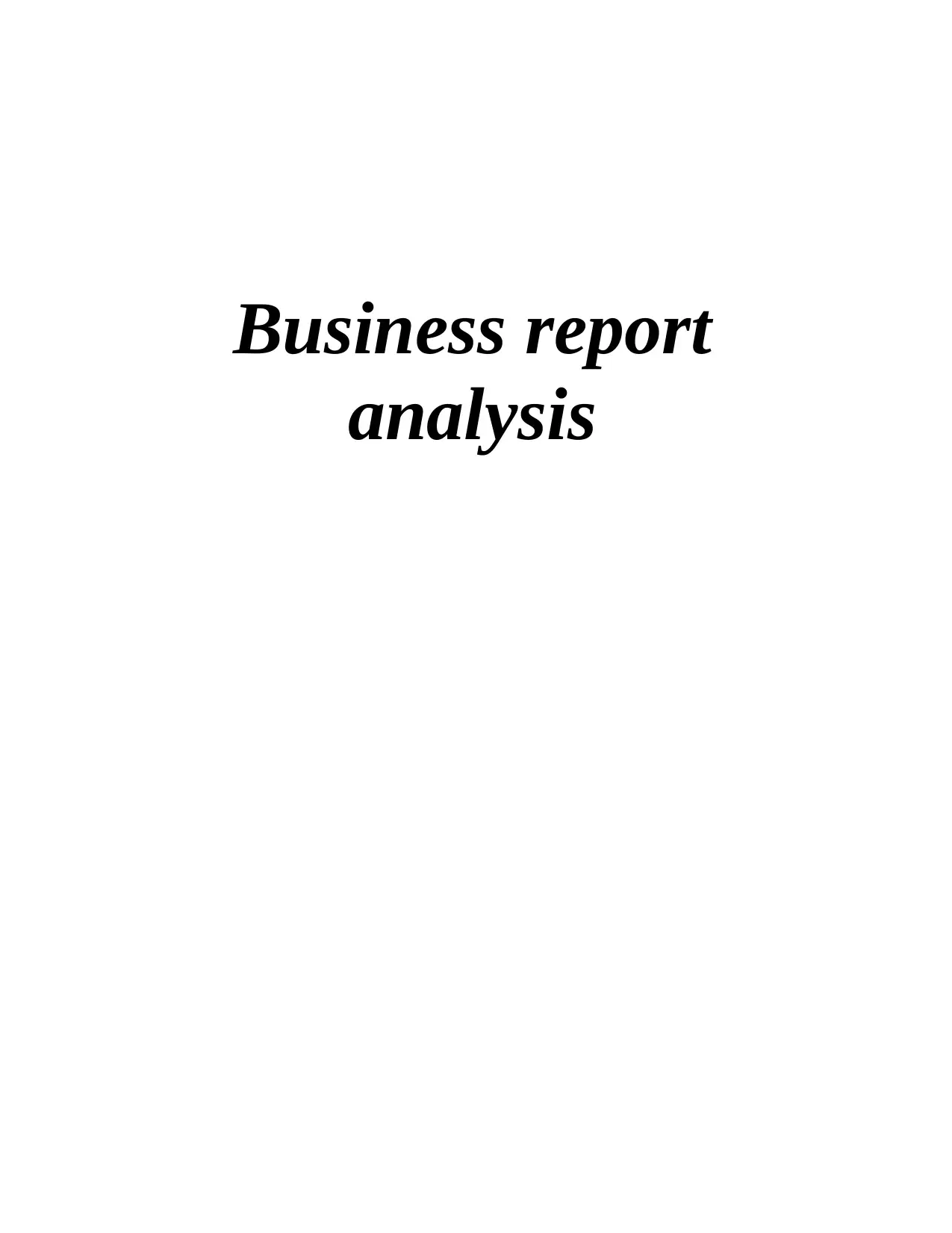
Business report
analysis
analysis
Paraphrase This Document
Need a fresh take? Get an instant paraphrase of this document with our AI Paraphraser
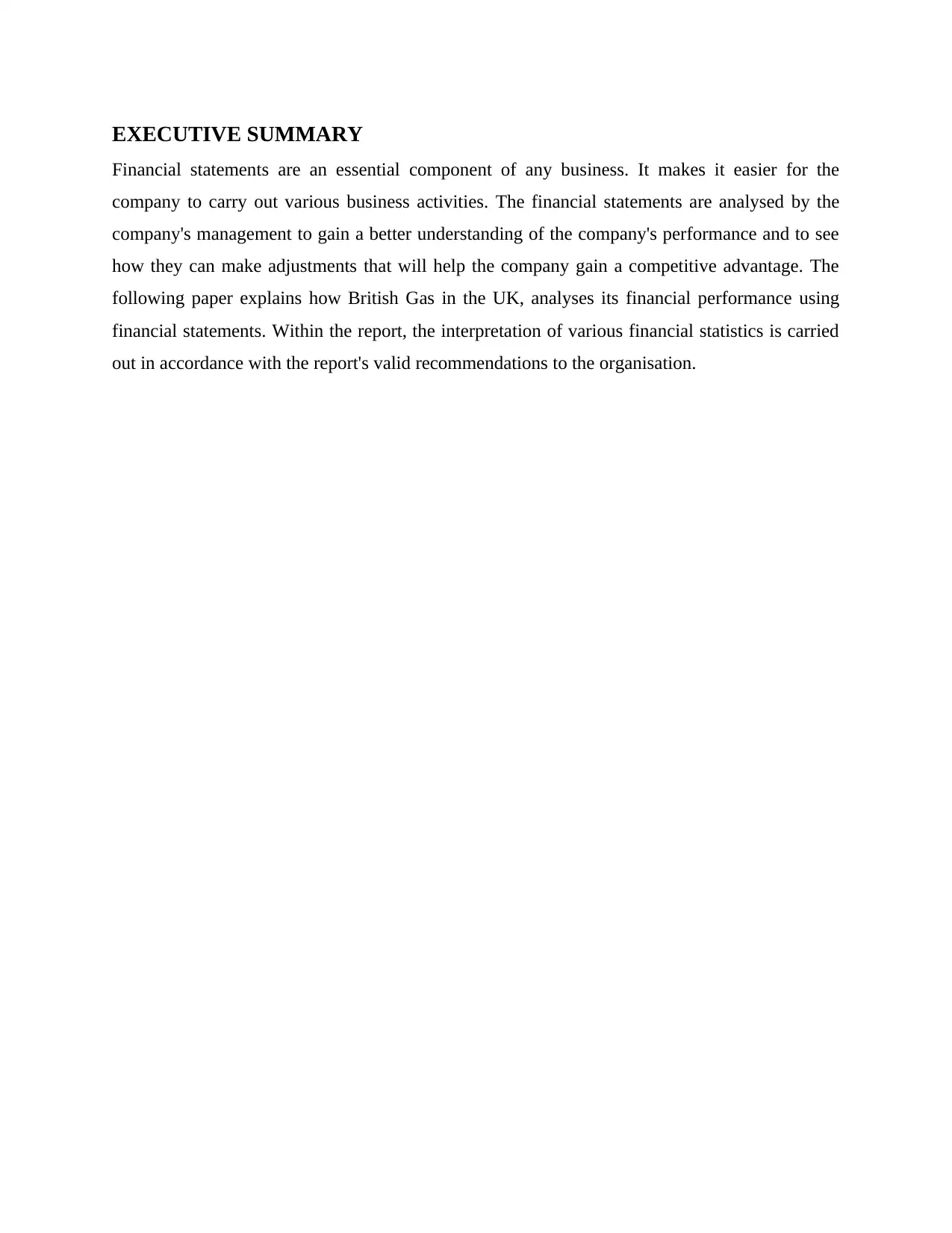
EXECUTIVE SUMMARY
Financial statements are an essential component of any business. It makes it easier for the
company to carry out various business activities. The financial statements are analysed by the
company's management to gain a better understanding of the company's performance and to see
how they can make adjustments that will help the company gain a competitive advantage. The
following paper explains how British Gas in the UK, analyses its financial performance using
financial statements. Within the report, the interpretation of various financial statistics is carried
out in accordance with the report's valid recommendations to the organisation.
Financial statements are an essential component of any business. It makes it easier for the
company to carry out various business activities. The financial statements are analysed by the
company's management to gain a better understanding of the company's performance and to see
how they can make adjustments that will help the company gain a competitive advantage. The
following paper explains how British Gas in the UK, analyses its financial performance using
financial statements. Within the report, the interpretation of various financial statistics is carried
out in accordance with the report's valid recommendations to the organisation.
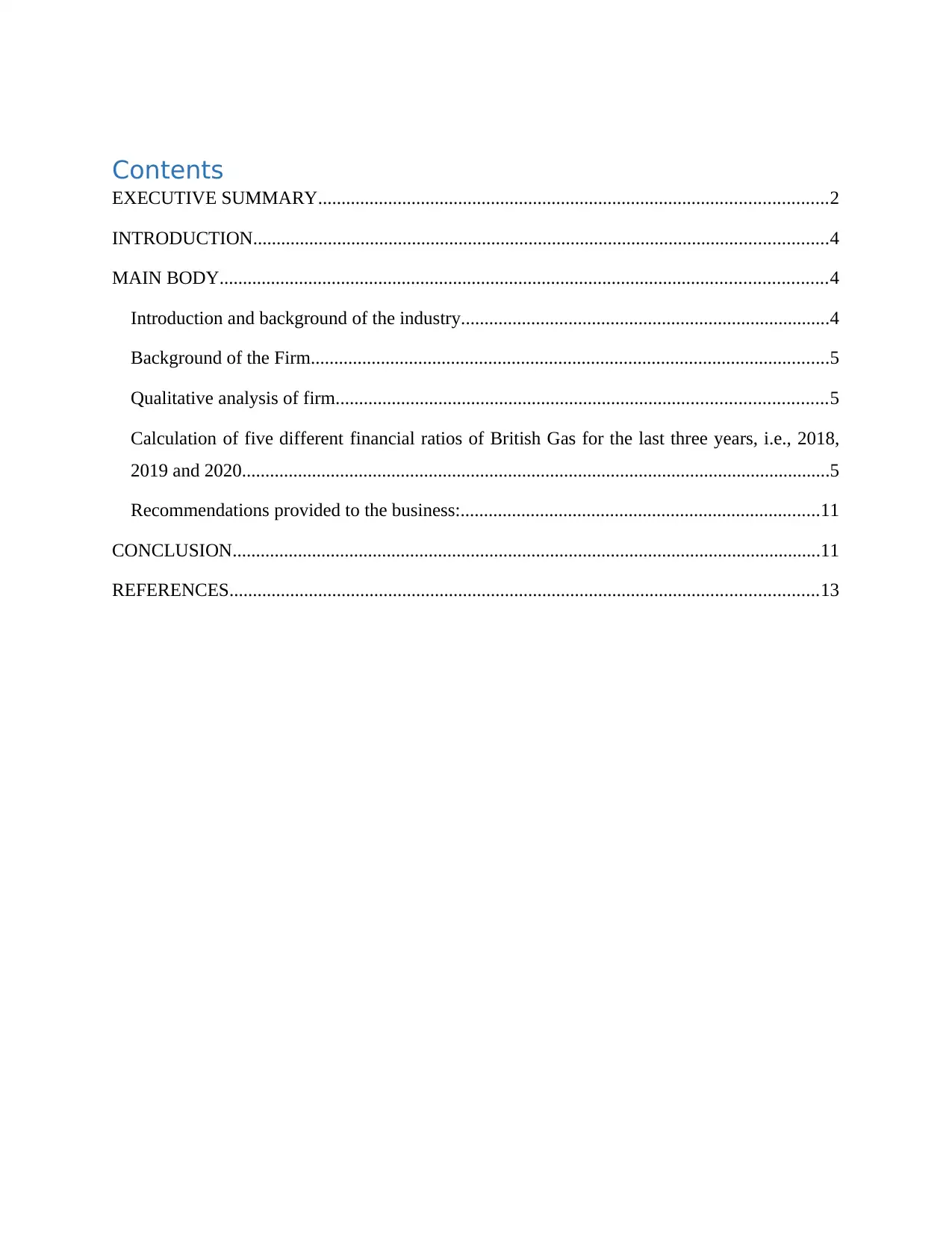
Contents
EXECUTIVE SUMMARY.............................................................................................................2
INTRODUCTION...........................................................................................................................4
MAIN BODY..................................................................................................................................4
Introduction and background of the industry...............................................................................4
Background of the Firm...............................................................................................................5
Qualitative analysis of firm.........................................................................................................5
Calculation of five different financial ratios of British Gas for the last three years, i.e., 2018,
2019 and 2020..............................................................................................................................5
Recommendations provided to the business:.............................................................................11
CONCLUSION..............................................................................................................................11
REFERENCES..............................................................................................................................13
EXECUTIVE SUMMARY.............................................................................................................2
INTRODUCTION...........................................................................................................................4
MAIN BODY..................................................................................................................................4
Introduction and background of the industry...............................................................................4
Background of the Firm...............................................................................................................5
Qualitative analysis of firm.........................................................................................................5
Calculation of five different financial ratios of British Gas for the last three years, i.e., 2018,
2019 and 2020..............................................................................................................................5
Recommendations provided to the business:.............................................................................11
CONCLUSION..............................................................................................................................11
REFERENCES..............................................................................................................................13
You're viewing a preview
Unlock full access by subscribing today!
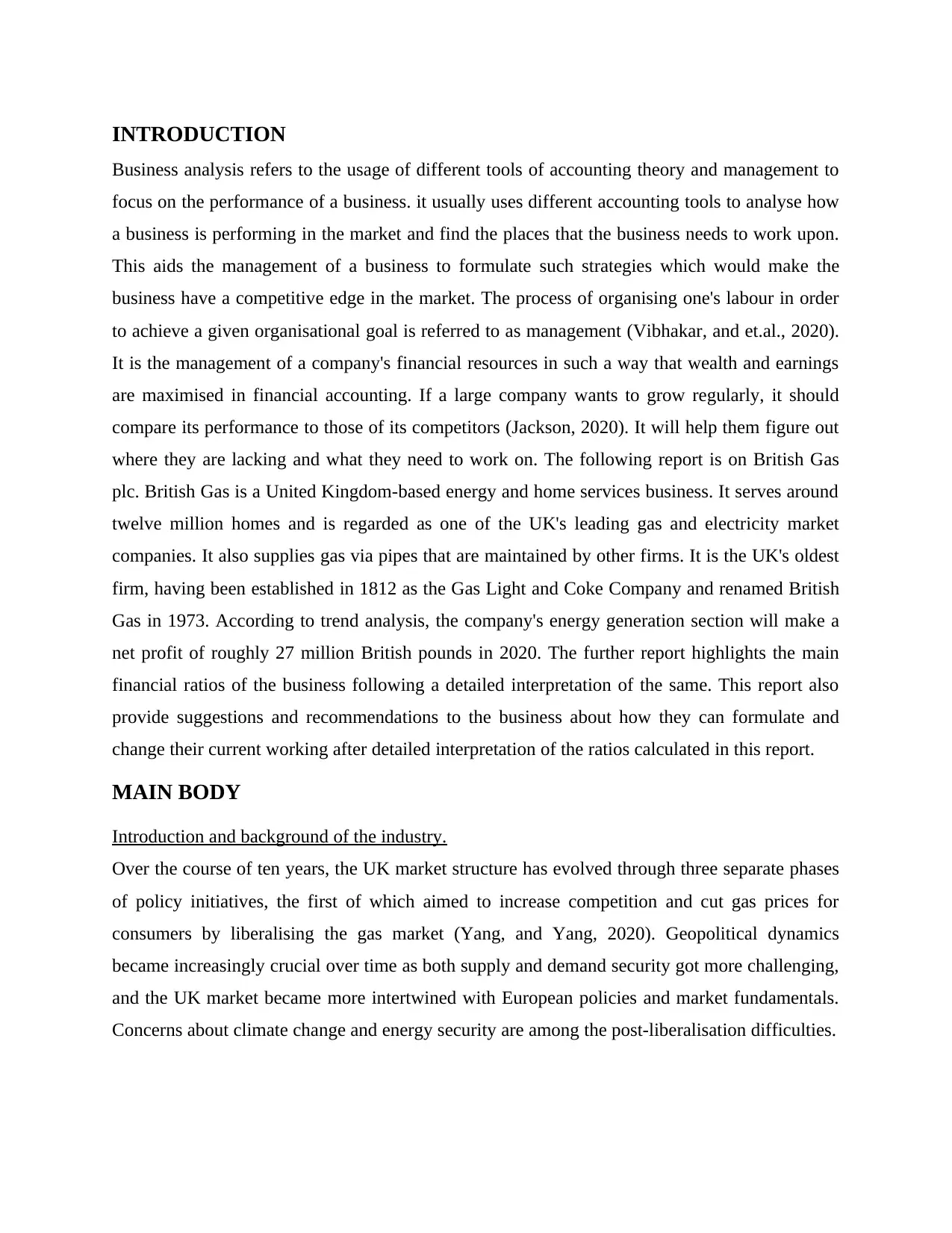
INTRODUCTION
Business analysis refers to the usage of different tools of accounting theory and management to
focus on the performance of a business. it usually uses different accounting tools to analyse how
a business is performing in the market and find the places that the business needs to work upon.
This aids the management of a business to formulate such strategies which would make the
business have a competitive edge in the market. The process of organising one's labour in order
to achieve a given organisational goal is referred to as management (Vibhakar, and et.al., 2020).
It is the management of a company's financial resources in such a way that wealth and earnings
are maximised in financial accounting. If a large company wants to grow regularly, it should
compare its performance to those of its competitors (Jackson, 2020). It will help them figure out
where they are lacking and what they need to work on. The following report is on British Gas
plc. British Gas is a United Kingdom-based energy and home services business. It serves around
twelve million homes and is regarded as one of the UK's leading gas and electricity market
companies. It also supplies gas via pipes that are maintained by other firms. It is the UK's oldest
firm, having been established in 1812 as the Gas Light and Coke Company and renamed British
Gas in 1973. According to trend analysis, the company's energy generation section will make a
net profit of roughly 27 million British pounds in 2020. The further report highlights the main
financial ratios of the business following a detailed interpretation of the same. This report also
provide suggestions and recommendations to the business about how they can formulate and
change their current working after detailed interpretation of the ratios calculated in this report.
MAIN BODY
Introduction and background of the industry.
Over the course of ten years, the UK market structure has evolved through three separate phases
of policy initiatives, the first of which aimed to increase competition and cut gas prices for
consumers by liberalising the gas market (Yang, and Yang, 2020). Geopolitical dynamics
became increasingly crucial over time as both supply and demand security got more challenging,
and the UK market became more intertwined with European policies and market fundamentals.
Concerns about climate change and energy security are among the post-liberalisation difficulties.
Business analysis refers to the usage of different tools of accounting theory and management to
focus on the performance of a business. it usually uses different accounting tools to analyse how
a business is performing in the market and find the places that the business needs to work upon.
This aids the management of a business to formulate such strategies which would make the
business have a competitive edge in the market. The process of organising one's labour in order
to achieve a given organisational goal is referred to as management (Vibhakar, and et.al., 2020).
It is the management of a company's financial resources in such a way that wealth and earnings
are maximised in financial accounting. If a large company wants to grow regularly, it should
compare its performance to those of its competitors (Jackson, 2020). It will help them figure out
where they are lacking and what they need to work on. The following report is on British Gas
plc. British Gas is a United Kingdom-based energy and home services business. It serves around
twelve million homes and is regarded as one of the UK's leading gas and electricity market
companies. It also supplies gas via pipes that are maintained by other firms. It is the UK's oldest
firm, having been established in 1812 as the Gas Light and Coke Company and renamed British
Gas in 1973. According to trend analysis, the company's energy generation section will make a
net profit of roughly 27 million British pounds in 2020. The further report highlights the main
financial ratios of the business following a detailed interpretation of the same. This report also
provide suggestions and recommendations to the business about how they can formulate and
change their current working after detailed interpretation of the ratios calculated in this report.
MAIN BODY
Introduction and background of the industry.
Over the course of ten years, the UK market structure has evolved through three separate phases
of policy initiatives, the first of which aimed to increase competition and cut gas prices for
consumers by liberalising the gas market (Yang, and Yang, 2020). Geopolitical dynamics
became increasingly crucial over time as both supply and demand security got more challenging,
and the UK market became more intertwined with European policies and market fundamentals.
Concerns about climate change and energy security are among the post-liberalisation difficulties.
Paraphrase This Document
Need a fresh take? Get an instant paraphrase of this document with our AI Paraphraser
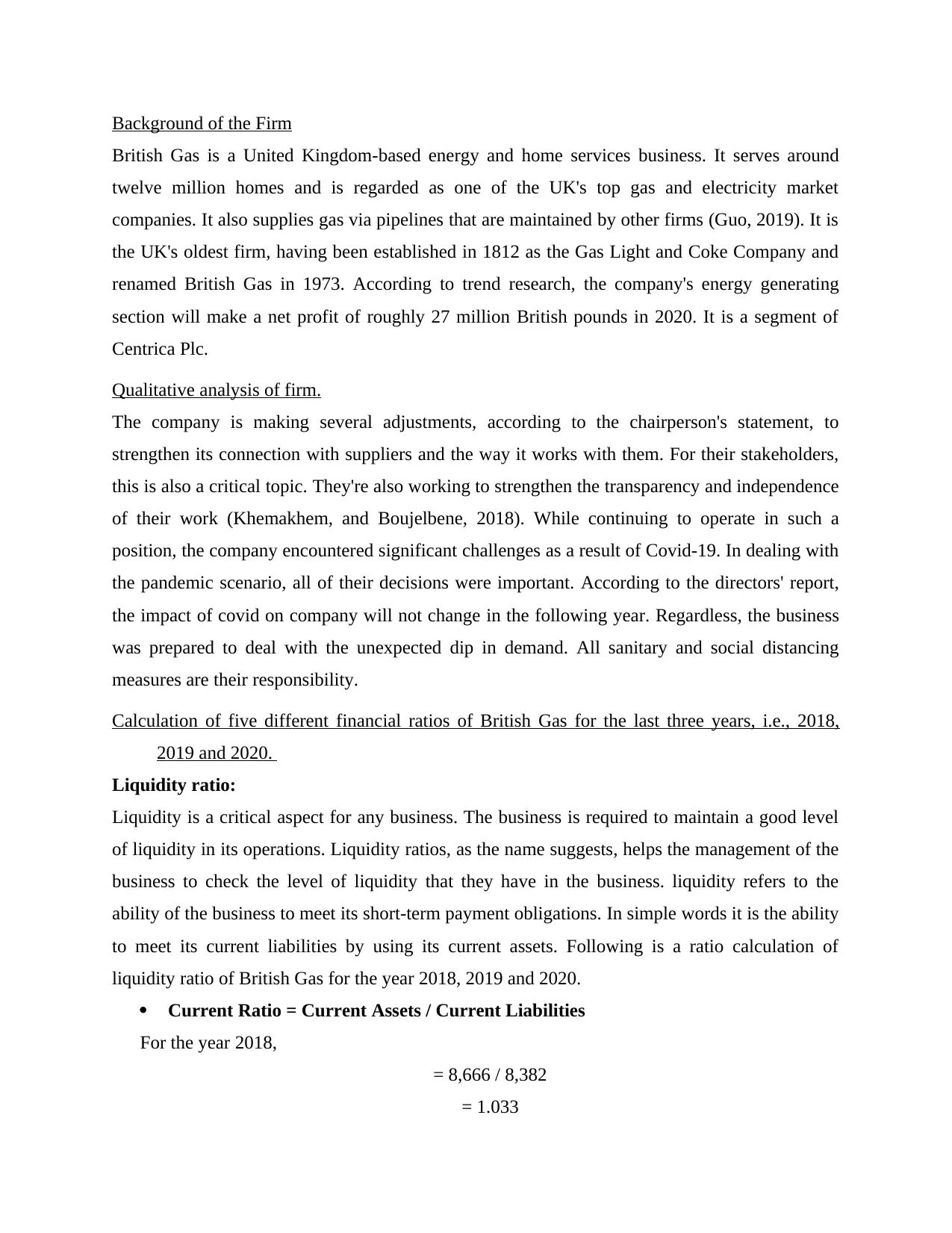
Background of the Firm
British Gas is a United Kingdom-based energy and home services business. It serves around
twelve million homes and is regarded as one of the UK's top gas and electricity market
companies. It also supplies gas via pipelines that are maintained by other firms (Guo, 2019). It is
the UK's oldest firm, having been established in 1812 as the Gas Light and Coke Company and
renamed British Gas in 1973. According to trend research, the company's energy generating
section will make a net profit of roughly 27 million British pounds in 2020. It is a segment of
Centrica Plc.
Qualitative analysis of firm.
The company is making several adjustments, according to the chairperson's statement, to
strengthen its connection with suppliers and the way it works with them. For their stakeholders,
this is also a critical topic. They're also working to strengthen the transparency and independence
of their work (Khemakhem, and Boujelbene, 2018). While continuing to operate in such a
position, the company encountered significant challenges as a result of Covid-19. In dealing with
the pandemic scenario, all of their decisions were important. According to the directors' report,
the impact of covid on company will not change in the following year. Regardless, the business
was prepared to deal with the unexpected dip in demand. All sanitary and social distancing
measures are their responsibility.
Calculation of five different financial ratios of British Gas for the last three years, i.e., 2018,
2019 and 2020.
Liquidity ratio:
Liquidity is a critical aspect for any business. The business is required to maintain a good level
of liquidity in its operations. Liquidity ratios, as the name suggests, helps the management of the
business to check the level of liquidity that they have in the business. liquidity refers to the
ability of the business to meet its short-term payment obligations. In simple words it is the ability
to meet its current liabilities by using its current assets. Following is a ratio calculation of
liquidity ratio of British Gas for the year 2018, 2019 and 2020.
Current Ratio = Current Assets / Current Liabilities
For the year 2018,
= 8,666 / 8,382
= 1.033
British Gas is a United Kingdom-based energy and home services business. It serves around
twelve million homes and is regarded as one of the UK's top gas and electricity market
companies. It also supplies gas via pipelines that are maintained by other firms (Guo, 2019). It is
the UK's oldest firm, having been established in 1812 as the Gas Light and Coke Company and
renamed British Gas in 1973. According to trend research, the company's energy generating
section will make a net profit of roughly 27 million British pounds in 2020. It is a segment of
Centrica Plc.
Qualitative analysis of firm.
The company is making several adjustments, according to the chairperson's statement, to
strengthen its connection with suppliers and the way it works with them. For their stakeholders,
this is also a critical topic. They're also working to strengthen the transparency and independence
of their work (Khemakhem, and Boujelbene, 2018). While continuing to operate in such a
position, the company encountered significant challenges as a result of Covid-19. In dealing with
the pandemic scenario, all of their decisions were important. According to the directors' report,
the impact of covid on company will not change in the following year. Regardless, the business
was prepared to deal with the unexpected dip in demand. All sanitary and social distancing
measures are their responsibility.
Calculation of five different financial ratios of British Gas for the last three years, i.e., 2018,
2019 and 2020.
Liquidity ratio:
Liquidity is a critical aspect for any business. The business is required to maintain a good level
of liquidity in its operations. Liquidity ratios, as the name suggests, helps the management of the
business to check the level of liquidity that they have in the business. liquidity refers to the
ability of the business to meet its short-term payment obligations. In simple words it is the ability
to meet its current liabilities by using its current assets. Following is a ratio calculation of
liquidity ratio of British Gas for the year 2018, 2019 and 2020.
Current Ratio = Current Assets / Current Liabilities
For the year 2018,
= 8,666 / 8,382
= 1.033
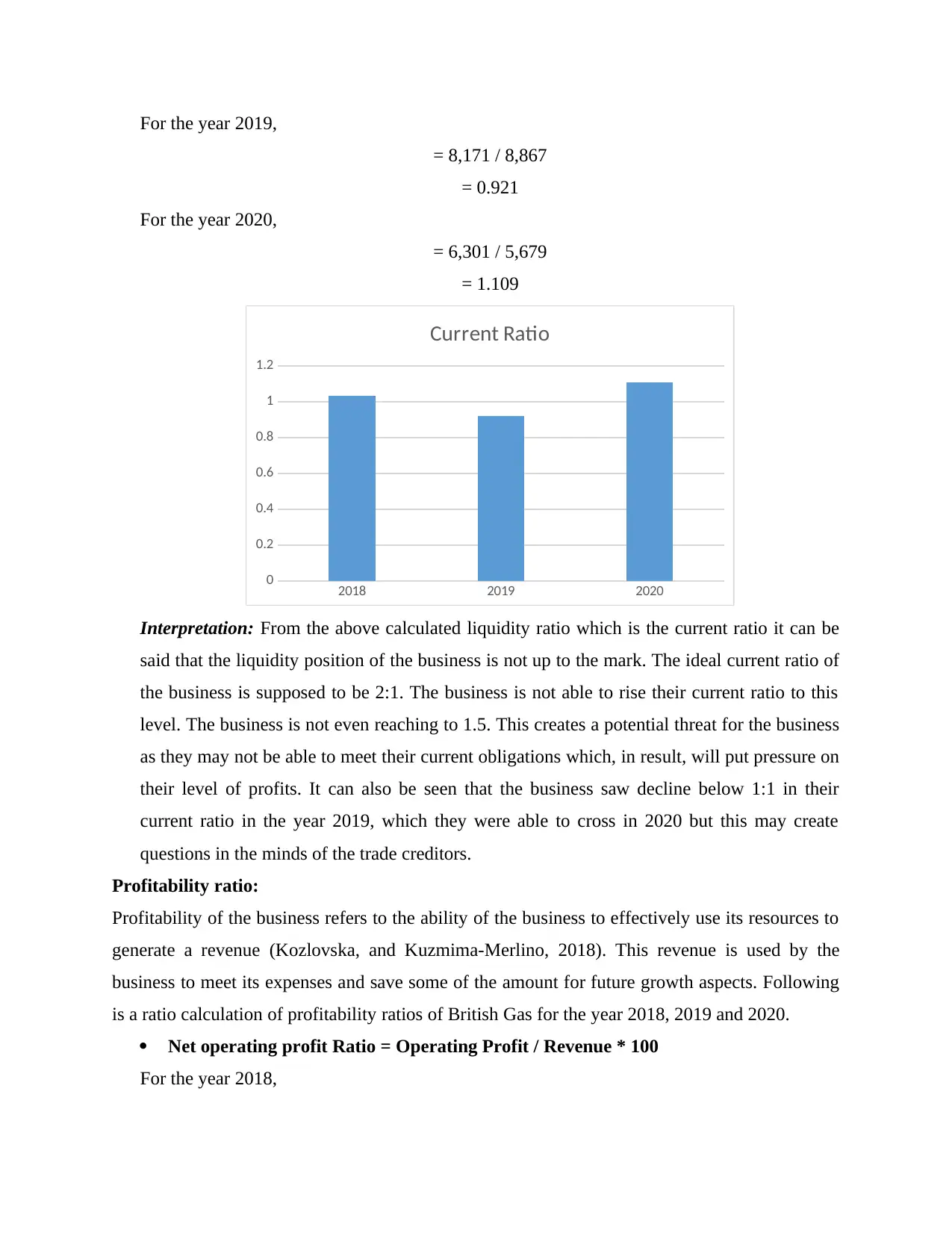
For the year 2019,
= 8,171 / 8,867
= 0.921
For the year 2020,
= 6,301 / 5,679
= 1.109
2018 2019 2020
0
0.2
0.4
0.6
0.8
1
1.2
Current Ratio
Interpretation: From the above calculated liquidity ratio which is the current ratio it can be
said that the liquidity position of the business is not up to the mark. The ideal current ratio of
the business is supposed to be 2:1. The business is not able to rise their current ratio to this
level. The business is not even reaching to 1.5. This creates a potential threat for the business
as they may not be able to meet their current obligations which, in result, will put pressure on
their level of profits. It can also be seen that the business saw decline below 1:1 in their
current ratio in the year 2019, which they were able to cross in 2020 but this may create
questions in the minds of the trade creditors.
Profitability ratio:
Profitability of the business refers to the ability of the business to effectively use its resources to
generate a revenue (Kozlovska, and Kuzmima-Merlino, 2018). This revenue is used by the
business to meet its expenses and save some of the amount for future growth aspects. Following
is a ratio calculation of profitability ratios of British Gas for the year 2018, 2019 and 2020.
Net operating profit Ratio = Operating Profit / Revenue * 100
For the year 2018,
= 8,171 / 8,867
= 0.921
For the year 2020,
= 6,301 / 5,679
= 1.109
2018 2019 2020
0
0.2
0.4
0.6
0.8
1
1.2
Current Ratio
Interpretation: From the above calculated liquidity ratio which is the current ratio it can be
said that the liquidity position of the business is not up to the mark. The ideal current ratio of
the business is supposed to be 2:1. The business is not able to rise their current ratio to this
level. The business is not even reaching to 1.5. This creates a potential threat for the business
as they may not be able to meet their current obligations which, in result, will put pressure on
their level of profits. It can also be seen that the business saw decline below 1:1 in their
current ratio in the year 2019, which they were able to cross in 2020 but this may create
questions in the minds of the trade creditors.
Profitability ratio:
Profitability of the business refers to the ability of the business to effectively use its resources to
generate a revenue (Kozlovska, and Kuzmima-Merlino, 2018). This revenue is used by the
business to meet its expenses and save some of the amount for future growth aspects. Following
is a ratio calculation of profitability ratios of British Gas for the year 2018, 2019 and 2020.
Net operating profit Ratio = Operating Profit / Revenue * 100
For the year 2018,
You're viewing a preview
Unlock full access by subscribing today!
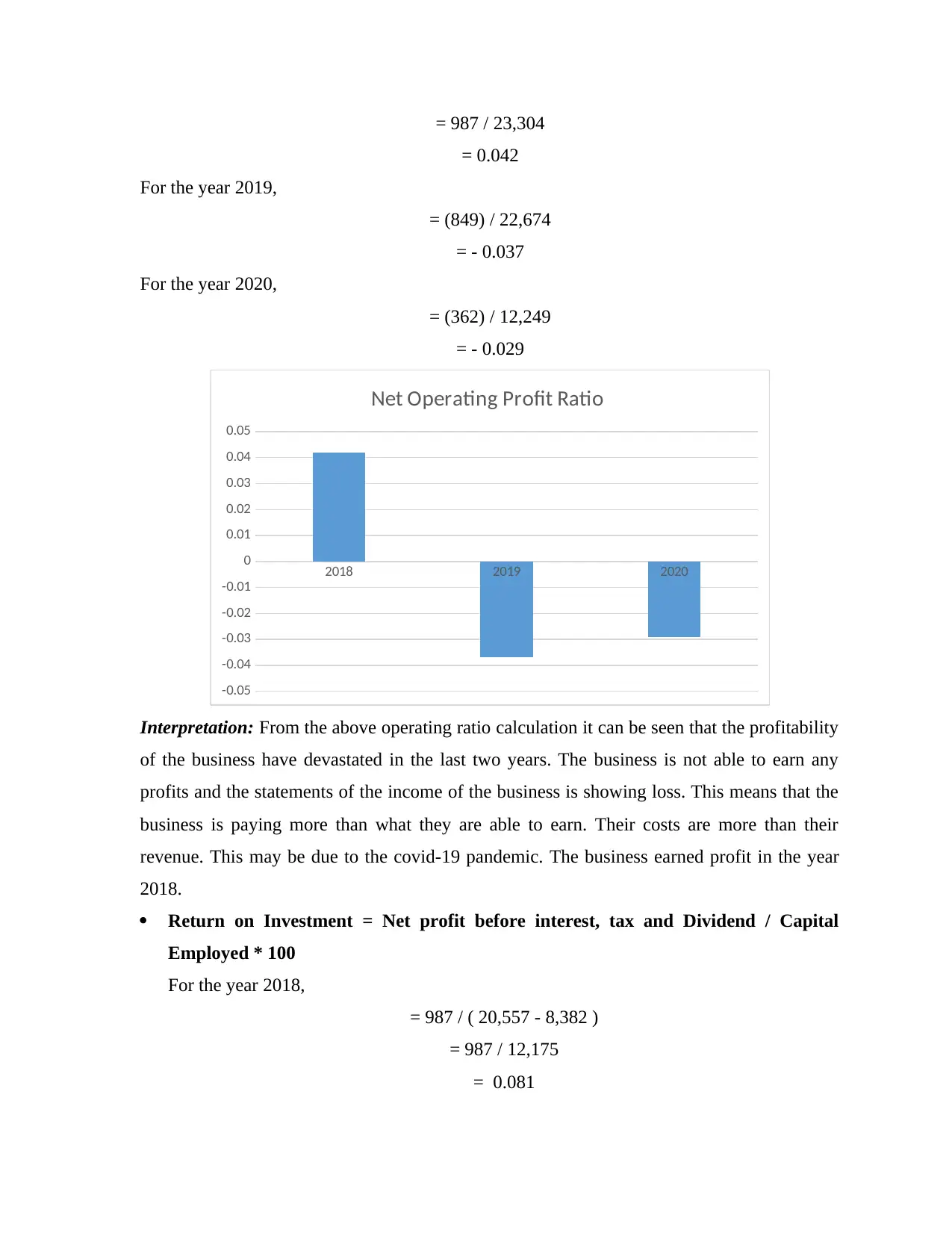
= 987 / 23,304
= 0.042
For the year 2019,
= (849) / 22,674
= - 0.037
For the year 2020,
= (362) / 12,249
= - 0.029
2018 2019 2020
-0.05
-0.04
-0.03
-0.02
-0.01
0
0.01
0.02
0.03
0.04
0.05
Net Operating Profit Ratio
Interpretation: From the above operating ratio calculation it can be seen that the profitability
of the business have devastated in the last two years. The business is not able to earn any
profits and the statements of the income of the business is showing loss. This means that the
business is paying more than what they are able to earn. Their costs are more than their
revenue. This may be due to the covid-19 pandemic. The business earned profit in the year
2018.
Return on Investment = Net profit before interest, tax and Dividend / Capital
Employed * 100
For the year 2018,
= 987 / ( 20,557 - 8,382 )
= 987 / 12,175
= 0.081
= 0.042
For the year 2019,
= (849) / 22,674
= - 0.037
For the year 2020,
= (362) / 12,249
= - 0.029
2018 2019 2020
-0.05
-0.04
-0.03
-0.02
-0.01
0
0.01
0.02
0.03
0.04
0.05
Net Operating Profit Ratio
Interpretation: From the above operating ratio calculation it can be seen that the profitability
of the business have devastated in the last two years. The business is not able to earn any
profits and the statements of the income of the business is showing loss. This means that the
business is paying more than what they are able to earn. Their costs are more than their
revenue. This may be due to the covid-19 pandemic. The business earned profit in the year
2018.
Return on Investment = Net profit before interest, tax and Dividend / Capital
Employed * 100
For the year 2018,
= 987 / ( 20,557 - 8,382 )
= 987 / 12,175
= 0.081
Paraphrase This Document
Need a fresh take? Get an instant paraphrase of this document with our AI Paraphraser
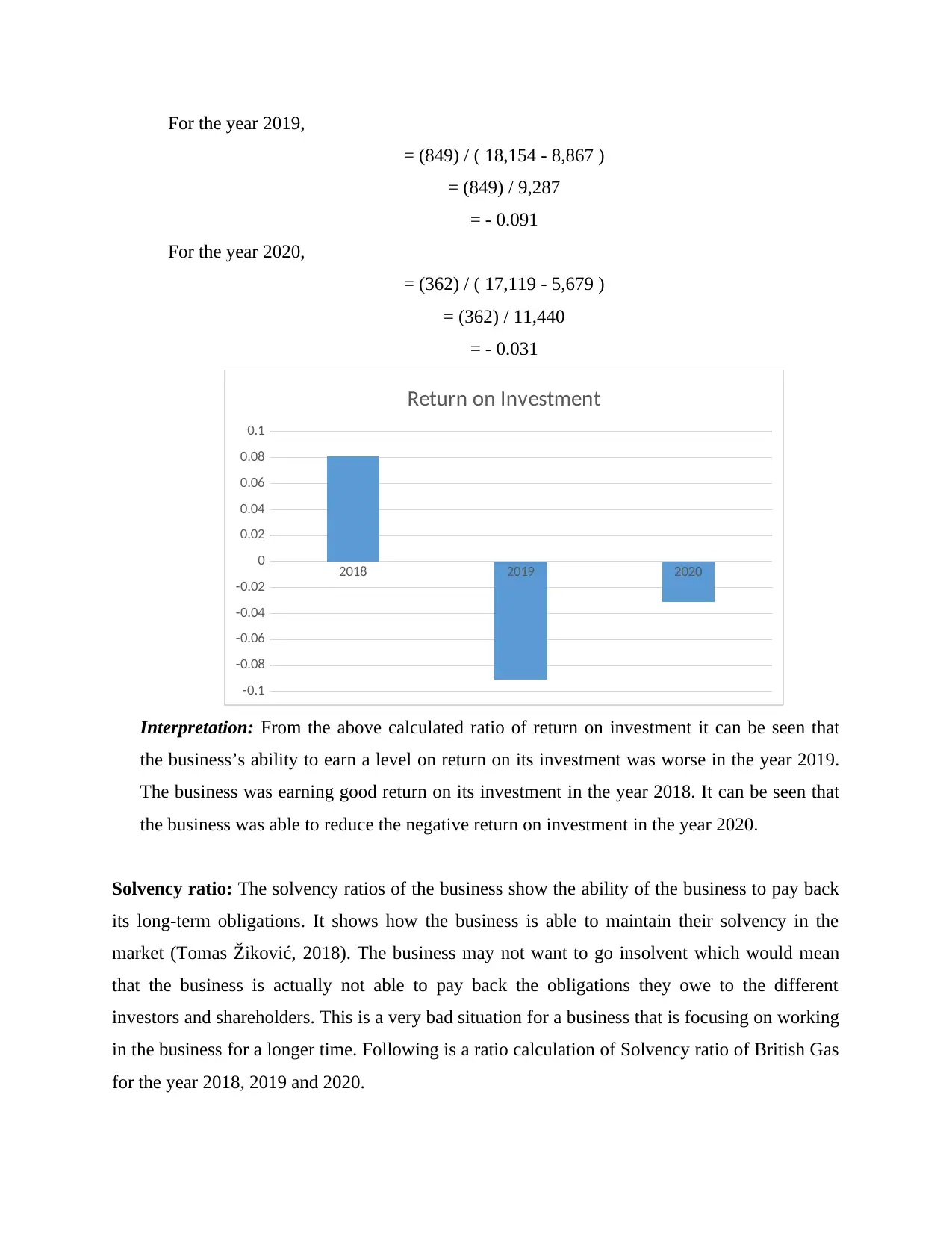
For the year 2019,
= (849) / ( 18,154 - 8,867 )
= (849) / 9,287
= - 0.091
For the year 2020,
= (362) / ( 17,119 - 5,679 )
= (362) / 11,440
= - 0.031
2018 2019 2020
-0.1
-0.08
-0.06
-0.04
-0.02
0
0.02
0.04
0.06
0.08
0.1
Return on Investment
Interpretation: From the above calculated ratio of return on investment it can be seen that
the business’s ability to earn a level on return on its investment was worse in the year 2019.
The business was earning good return on its investment in the year 2018. It can be seen that
the business was able to reduce the negative return on investment in the year 2020.
Solvency ratio: The solvency ratios of the business show the ability of the business to pay back
its long-term obligations. It shows how the business is able to maintain their solvency in the
market (Tomas Žiković, 2018). The business may not want to go insolvent which would mean
that the business is actually not able to pay back the obligations they owe to the different
investors and shareholders. This is a very bad situation for a business that is focusing on working
in the business for a longer time. Following is a ratio calculation of Solvency ratio of British Gas
for the year 2018, 2019 and 2020.
= (849) / ( 18,154 - 8,867 )
= (849) / 9,287
= - 0.091
For the year 2020,
= (362) / ( 17,119 - 5,679 )
= (362) / 11,440
= - 0.031
2018 2019 2020
-0.1
-0.08
-0.06
-0.04
-0.02
0
0.02
0.04
0.06
0.08
0.1
Return on Investment
Interpretation: From the above calculated ratio of return on investment it can be seen that
the business’s ability to earn a level on return on its investment was worse in the year 2019.
The business was earning good return on its investment in the year 2018. It can be seen that
the business was able to reduce the negative return on investment in the year 2020.
Solvency ratio: The solvency ratios of the business show the ability of the business to pay back
its long-term obligations. It shows how the business is able to maintain their solvency in the
market (Tomas Žiković, 2018). The business may not want to go insolvent which would mean
that the business is actually not able to pay back the obligations they owe to the different
investors and shareholders. This is a very bad situation for a business that is focusing on working
in the business for a longer time. Following is a ratio calculation of Solvency ratio of British Gas
for the year 2018, 2019 and 2020.
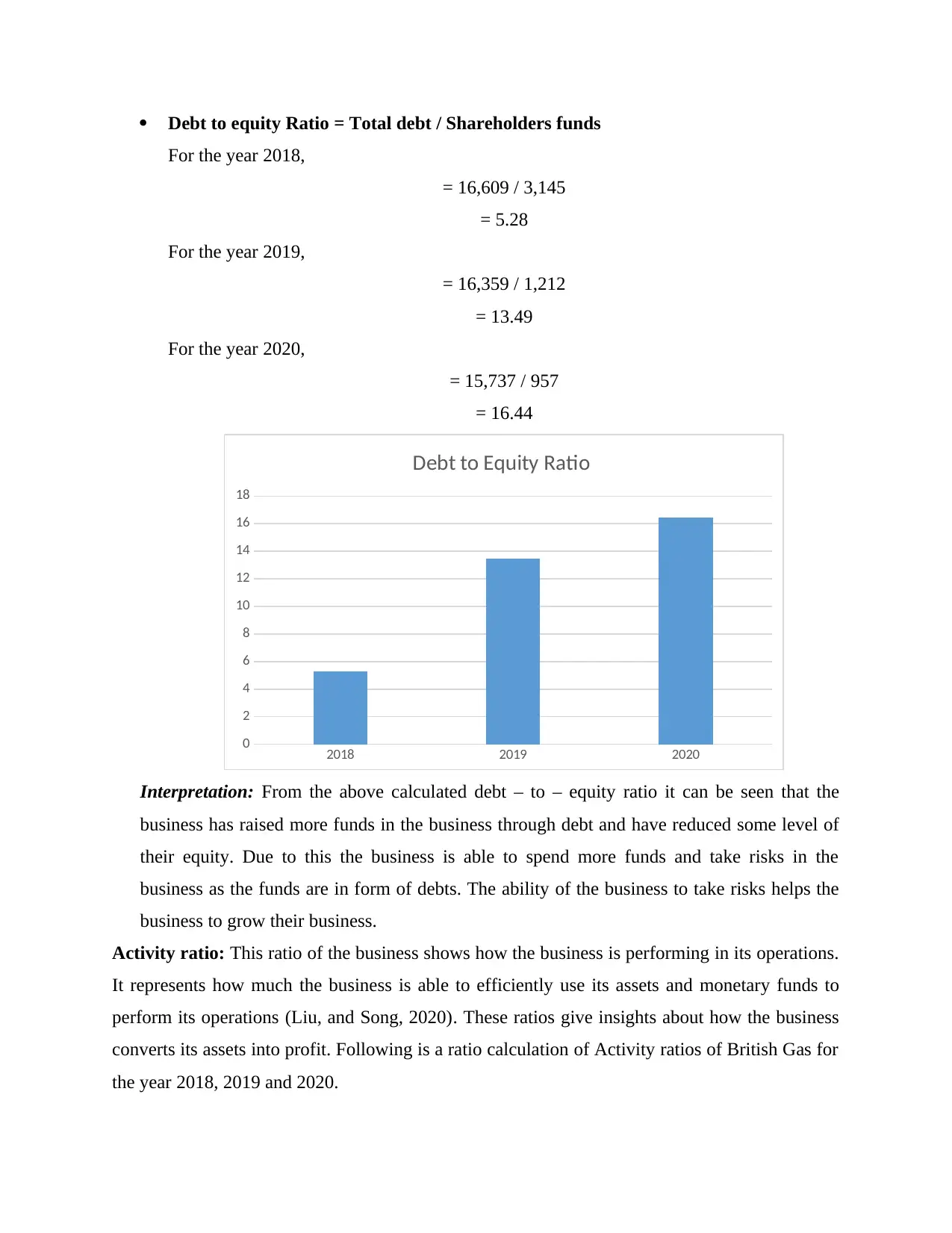
Debt to equity Ratio = Total debt / Shareholders funds
For the year 2018,
= 16,609 / 3,145
= 5.28
For the year 2019,
= 16,359 / 1,212
= 13.49
For the year 2020,
= 15,737 / 957
= 16.44
2018 2019 2020
0
2
4
6
8
10
12
14
16
18
Debt to Equity Ratio
Interpretation: From the above calculated debt – to – equity ratio it can be seen that the
business has raised more funds in the business through debt and have reduced some level of
their equity. Due to this the business is able to spend more funds and take risks in the
business as the funds are in form of debts. The ability of the business to take risks helps the
business to grow their business.
Activity ratio: This ratio of the business shows how the business is performing in its operations.
It represents how much the business is able to efficiently use its assets and monetary funds to
perform its operations (Liu, and Song, 2020). These ratios give insights about how the business
converts its assets into profit. Following is a ratio calculation of Activity ratios of British Gas for
the year 2018, 2019 and 2020.
For the year 2018,
= 16,609 / 3,145
= 5.28
For the year 2019,
= 16,359 / 1,212
= 13.49
For the year 2020,
= 15,737 / 957
= 16.44
2018 2019 2020
0
2
4
6
8
10
12
14
16
18
Debt to Equity Ratio
Interpretation: From the above calculated debt – to – equity ratio it can be seen that the
business has raised more funds in the business through debt and have reduced some level of
their equity. Due to this the business is able to spend more funds and take risks in the
business as the funds are in form of debts. The ability of the business to take risks helps the
business to grow their business.
Activity ratio: This ratio of the business shows how the business is performing in its operations.
It represents how much the business is able to efficiently use its assets and monetary funds to
perform its operations (Liu, and Song, 2020). These ratios give insights about how the business
converts its assets into profit. Following is a ratio calculation of Activity ratios of British Gas for
the year 2018, 2019 and 2020.
You're viewing a preview
Unlock full access by subscribing today!
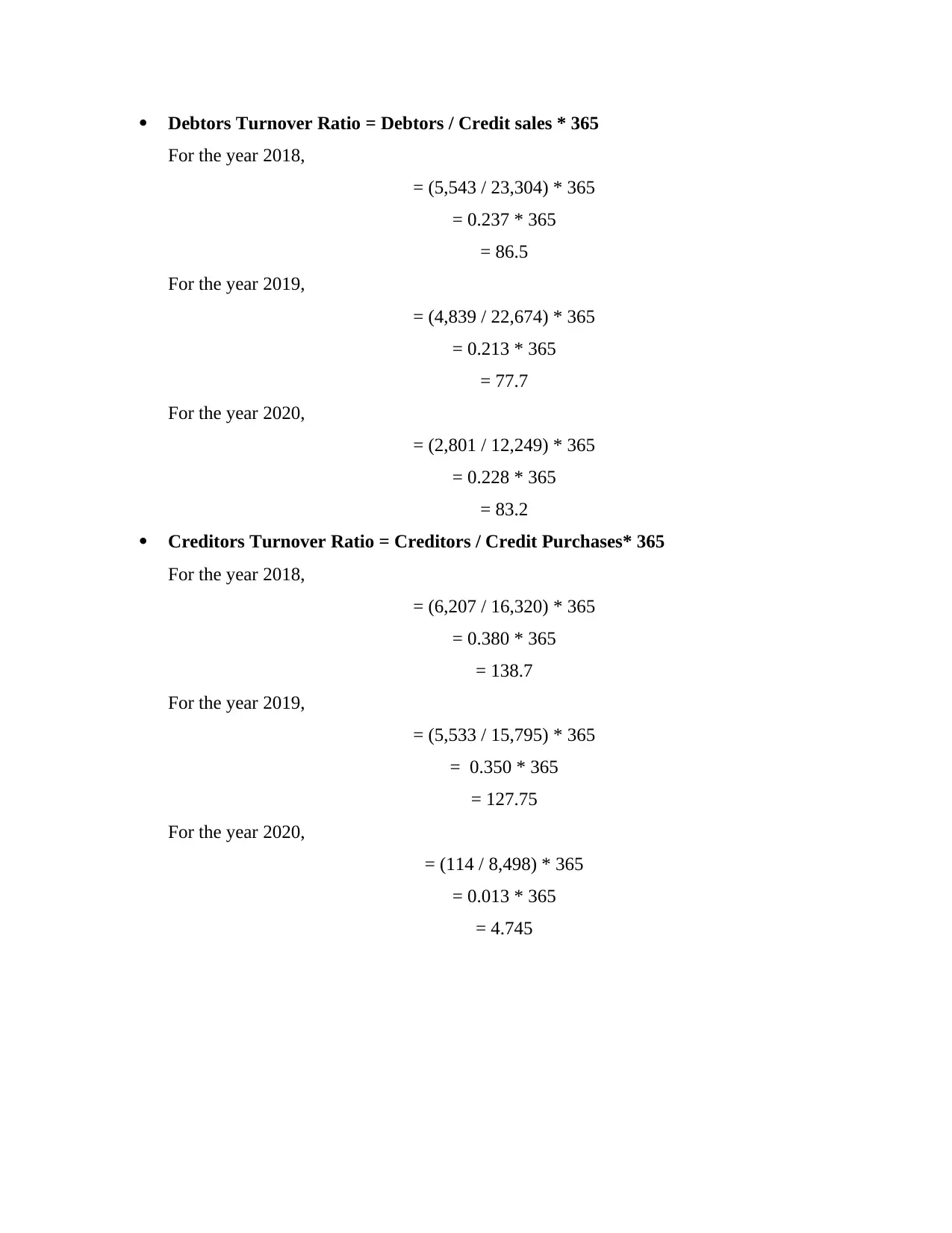
Debtors Turnover Ratio = Debtors / Credit sales * 365
For the year 2018,
= (5,543 / 23,304) * 365
= 0.237 * 365
= 86.5
For the year 2019,
= (4,839 / 22,674) * 365
= 0.213 * 365
= 77.7
For the year 2020,
= (2,801 / 12,249) * 365
= 0.228 * 365
= 83.2
Creditors Turnover Ratio = Creditors / Credit Purchases* 365
For the year 2018,
= (6,207 / 16,320) * 365
= 0.380 * 365
= 138.7
For the year 2019,
= (5,533 / 15,795) * 365
= 0.350 * 365
= 127.75
For the year 2020,
= (114 / 8,498) * 365
= 0.013 * 365
= 4.745
For the year 2018,
= (5,543 / 23,304) * 365
= 0.237 * 365
= 86.5
For the year 2019,
= (4,839 / 22,674) * 365
= 0.213 * 365
= 77.7
For the year 2020,
= (2,801 / 12,249) * 365
= 0.228 * 365
= 83.2
Creditors Turnover Ratio = Creditors / Credit Purchases* 365
For the year 2018,
= (6,207 / 16,320) * 365
= 0.380 * 365
= 138.7
For the year 2019,
= (5,533 / 15,795) * 365
= 0.350 * 365
= 127.75
For the year 2020,
= (114 / 8,498) * 365
= 0.013 * 365
= 4.745
Paraphrase This Document
Need a fresh take? Get an instant paraphrase of this document with our AI Paraphraser
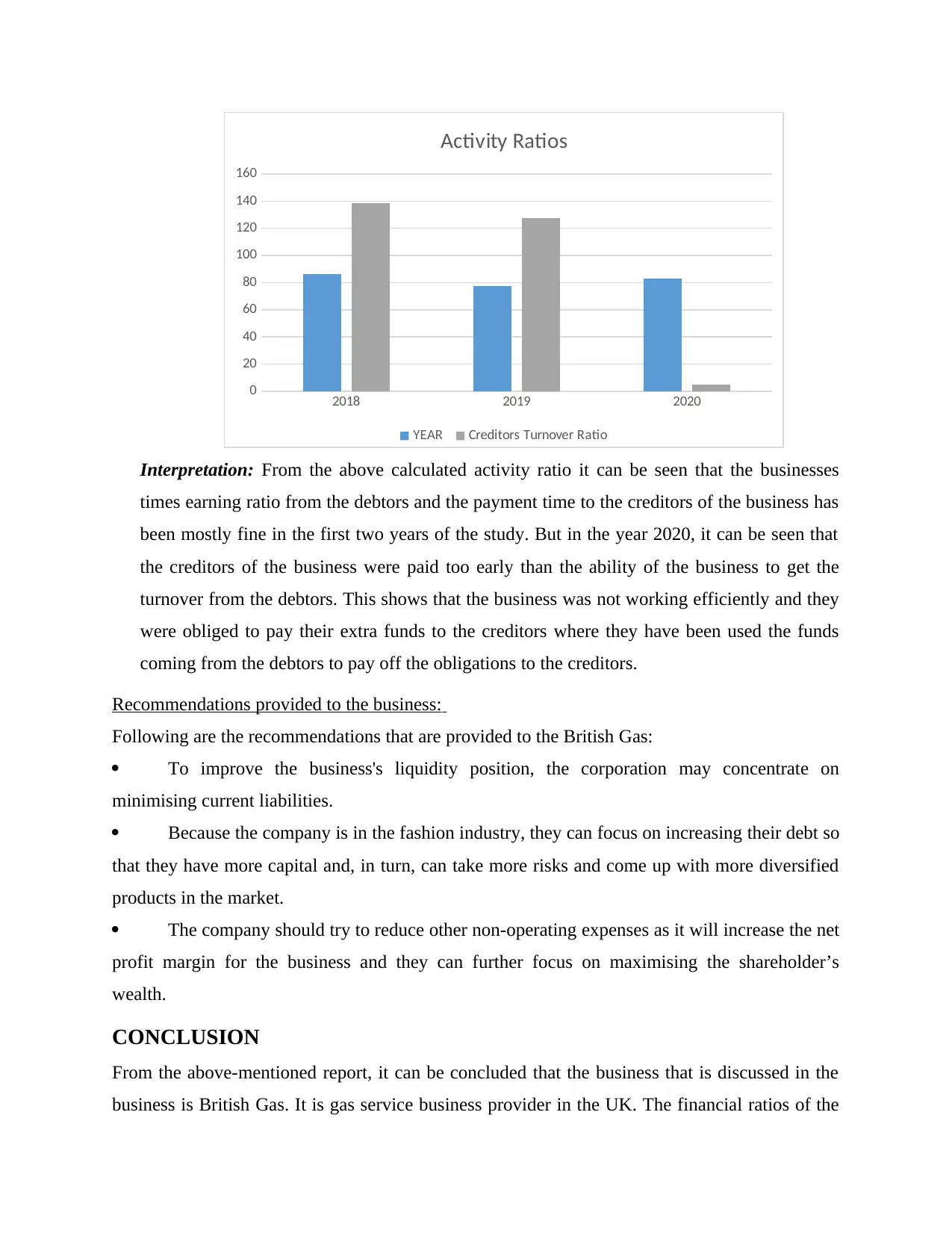
2018 2019 2020
0
20
40
60
80
100
120
140
160
Activity Ratios
YEAR Creditors Turnover Ratio
Interpretation: From the above calculated activity ratio it can be seen that the businesses
times earning ratio from the debtors and the payment time to the creditors of the business has
been mostly fine in the first two years of the study. But in the year 2020, it can be seen that
the creditors of the business were paid too early than the ability of the business to get the
turnover from the debtors. This shows that the business was not working efficiently and they
were obliged to pay their extra funds to the creditors where they have been used the funds
coming from the debtors to pay off the obligations to the creditors.
Recommendations provided to the business:
Following are the recommendations that are provided to the British Gas:
To improve the business's liquidity position, the corporation may concentrate on
minimising current liabilities.
Because the company is in the fashion industry, they can focus on increasing their debt so
that they have more capital and, in turn, can take more risks and come up with more diversified
products in the market.
The company should try to reduce other non-operating expenses as it will increase the net
profit margin for the business and they can further focus on maximising the shareholder’s
wealth.
CONCLUSION
From the above-mentioned report, it can be concluded that the business that is discussed in the
business is British Gas. It is gas service business provider in the UK. The financial ratios of the
0
20
40
60
80
100
120
140
160
Activity Ratios
YEAR Creditors Turnover Ratio
Interpretation: From the above calculated activity ratio it can be seen that the businesses
times earning ratio from the debtors and the payment time to the creditors of the business has
been mostly fine in the first two years of the study. But in the year 2020, it can be seen that
the creditors of the business were paid too early than the ability of the business to get the
turnover from the debtors. This shows that the business was not working efficiently and they
were obliged to pay their extra funds to the creditors where they have been used the funds
coming from the debtors to pay off the obligations to the creditors.
Recommendations provided to the business:
Following are the recommendations that are provided to the British Gas:
To improve the business's liquidity position, the corporation may concentrate on
minimising current liabilities.
Because the company is in the fashion industry, they can focus on increasing their debt so
that they have more capital and, in turn, can take more risks and come up with more diversified
products in the market.
The company should try to reduce other non-operating expenses as it will increase the net
profit margin for the business and they can further focus on maximising the shareholder’s
wealth.
CONCLUSION
From the above-mentioned report, it can be concluded that the business that is discussed in the
business is British Gas. It is gas service business provider in the UK. The financial ratios of the
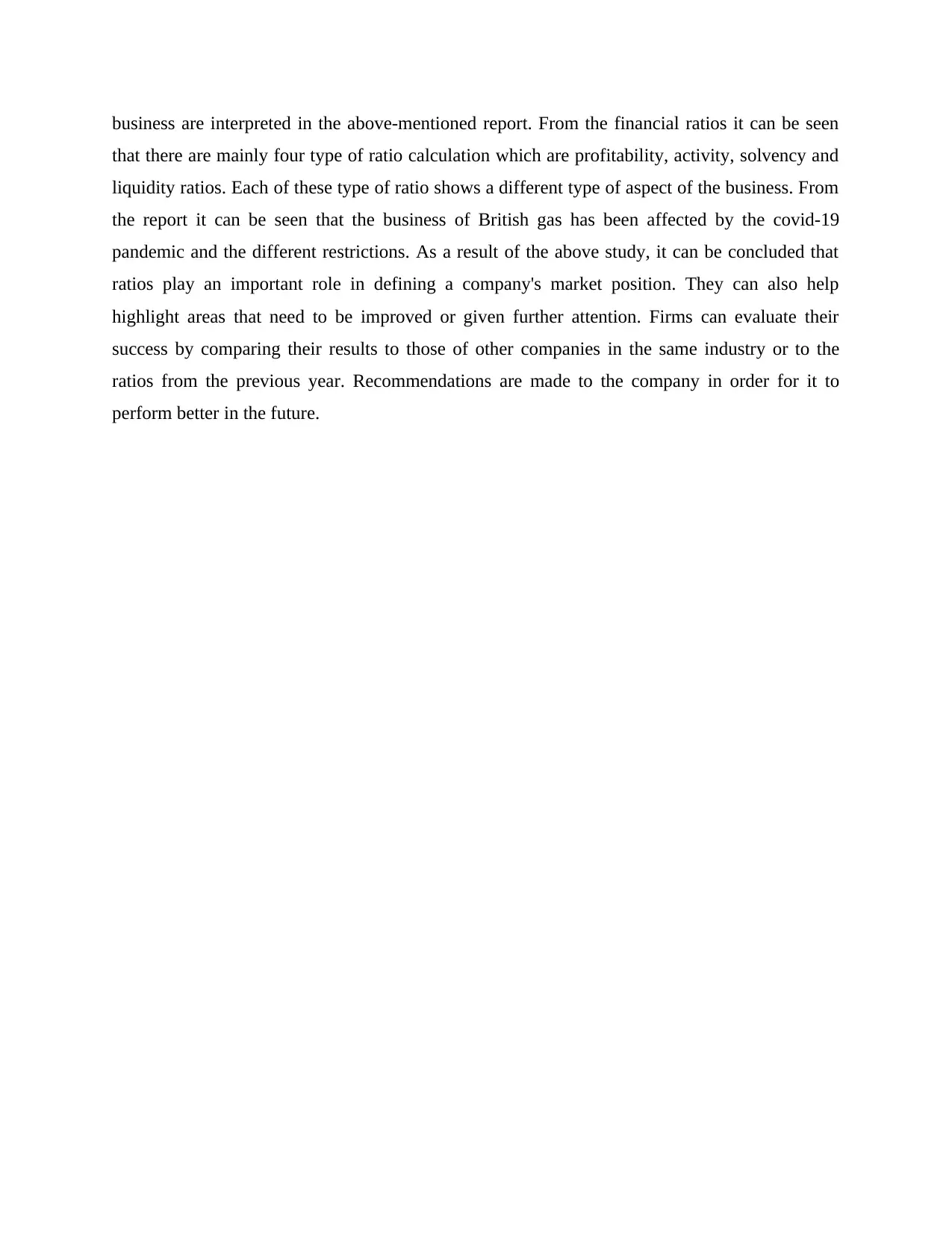
business are interpreted in the above-mentioned report. From the financial ratios it can be seen
that there are mainly four type of ratio calculation which are profitability, activity, solvency and
liquidity ratios. Each of these type of ratio shows a different type of aspect of the business. From
the report it can be seen that the business of British gas has been affected by the covid-19
pandemic and the different restrictions. As a result of the above study, it can be concluded that
ratios play an important role in defining a company's market position. They can also help
highlight areas that need to be improved or given further attention. Firms can evaluate their
success by comparing their results to those of other companies in the same industry or to the
ratios from the previous year. Recommendations are made to the company in order for it to
perform better in the future.
that there are mainly four type of ratio calculation which are profitability, activity, solvency and
liquidity ratios. Each of these type of ratio shows a different type of aspect of the business. From
the report it can be seen that the business of British gas has been affected by the covid-19
pandemic and the different restrictions. As a result of the above study, it can be concluded that
ratios play an important role in defining a company's market position. They can also help
highlight areas that need to be improved or given further attention. Firms can evaluate their
success by comparing their results to those of other companies in the same industry or to the
ratios from the previous year. Recommendations are made to the company in order for it to
perform better in the future.
You're viewing a preview
Unlock full access by subscribing today!

REFERENCES
Books and Journals
Vibhakar, N.N., and et.al., 2020. Identification of significant financial performance indicators for
the Indian construction companies. International Journal of Construction Management,
pp.1-11.
Yang, Y. and Yang, C., 2020, February. Research on the application of GA improved neural
network in the prediction of financial crisis. In 2020 12th International Conference on
Measuring Technology and Mechatronics Automation (ICMTMA) (pp. 625-629).
IEEE.
Khemakhem, S. and Boujelbene, Y., 2018. Predicting credit risk on the basis of financial and
non-financial variables and data mining. Review of Accounting and Finance.
Kozlovska, I. and Kuzmima-Merlino, I., 2018, October. Linkage Between Management of Long-
Lived Non-financial Assets and Performance of Latvian Companies Listed on the Baltic
Stock Exchange. In International Conference on Reliability and Statistics in
Transportation and Communication (pp. 684-693). Springer, Cham.
Tomas Žiković, I., 2018. Challenges in Predicting Financial Distress in Emerging Economies:
The Case of Croatia. Eastern European Economics, 56(1), pp.1-27.
Liu, H. and Song, Y., 2020. Financial development and carbon emissions in China since the
recent world financial crisis: Evidence from a spatial-temporal analysis and a spatial
Durbin model. Science of the Total Environment, 715, p.136771.
Guo, X., 2019, October. Research on enterprise financial risk control based on intelligent system.
In 2019 12th International Conference on Intelligent Computation Technology and
Automation (ICICTA) (pp. 529-534). IEEE.
Chu, Y.H., 2018. 9. Surviving the East Asian Financial Storm: The Political Foundation of
Taiwan's Economic Resilience. In The politics of the Asian economic crisis (pp. 184-
202). Cornell University Press.
Golovkova, A., and et.al., 2019. Customer satisfaction index and financial performance: a
European cross country study. International Journal of Bank Marketing.
Books and Journals
Vibhakar, N.N., and et.al., 2020. Identification of significant financial performance indicators for
the Indian construction companies. International Journal of Construction Management,
pp.1-11.
Yang, Y. and Yang, C., 2020, February. Research on the application of GA improved neural
network in the prediction of financial crisis. In 2020 12th International Conference on
Measuring Technology and Mechatronics Automation (ICMTMA) (pp. 625-629).
IEEE.
Khemakhem, S. and Boujelbene, Y., 2018. Predicting credit risk on the basis of financial and
non-financial variables and data mining. Review of Accounting and Finance.
Kozlovska, I. and Kuzmima-Merlino, I., 2018, October. Linkage Between Management of Long-
Lived Non-financial Assets and Performance of Latvian Companies Listed on the Baltic
Stock Exchange. In International Conference on Reliability and Statistics in
Transportation and Communication (pp. 684-693). Springer, Cham.
Tomas Žiković, I., 2018. Challenges in Predicting Financial Distress in Emerging Economies:
The Case of Croatia. Eastern European Economics, 56(1), pp.1-27.
Liu, H. and Song, Y., 2020. Financial development and carbon emissions in China since the
recent world financial crisis: Evidence from a spatial-temporal analysis and a spatial
Durbin model. Science of the Total Environment, 715, p.136771.
Guo, X., 2019, October. Research on enterprise financial risk control based on intelligent system.
In 2019 12th International Conference on Intelligent Computation Technology and
Automation (ICICTA) (pp. 529-534). IEEE.
Chu, Y.H., 2018. 9. Surviving the East Asian Financial Storm: The Political Foundation of
Taiwan's Economic Resilience. In The politics of the Asian economic crisis (pp. 184-
202). Cornell University Press.
Golovkova, A., and et.al., 2019. Customer satisfaction index and financial performance: a
European cross country study. International Journal of Bank Marketing.
Paraphrase This Document
Need a fresh take? Get an instant paraphrase of this document with our AI Paraphraser

APPENDIX
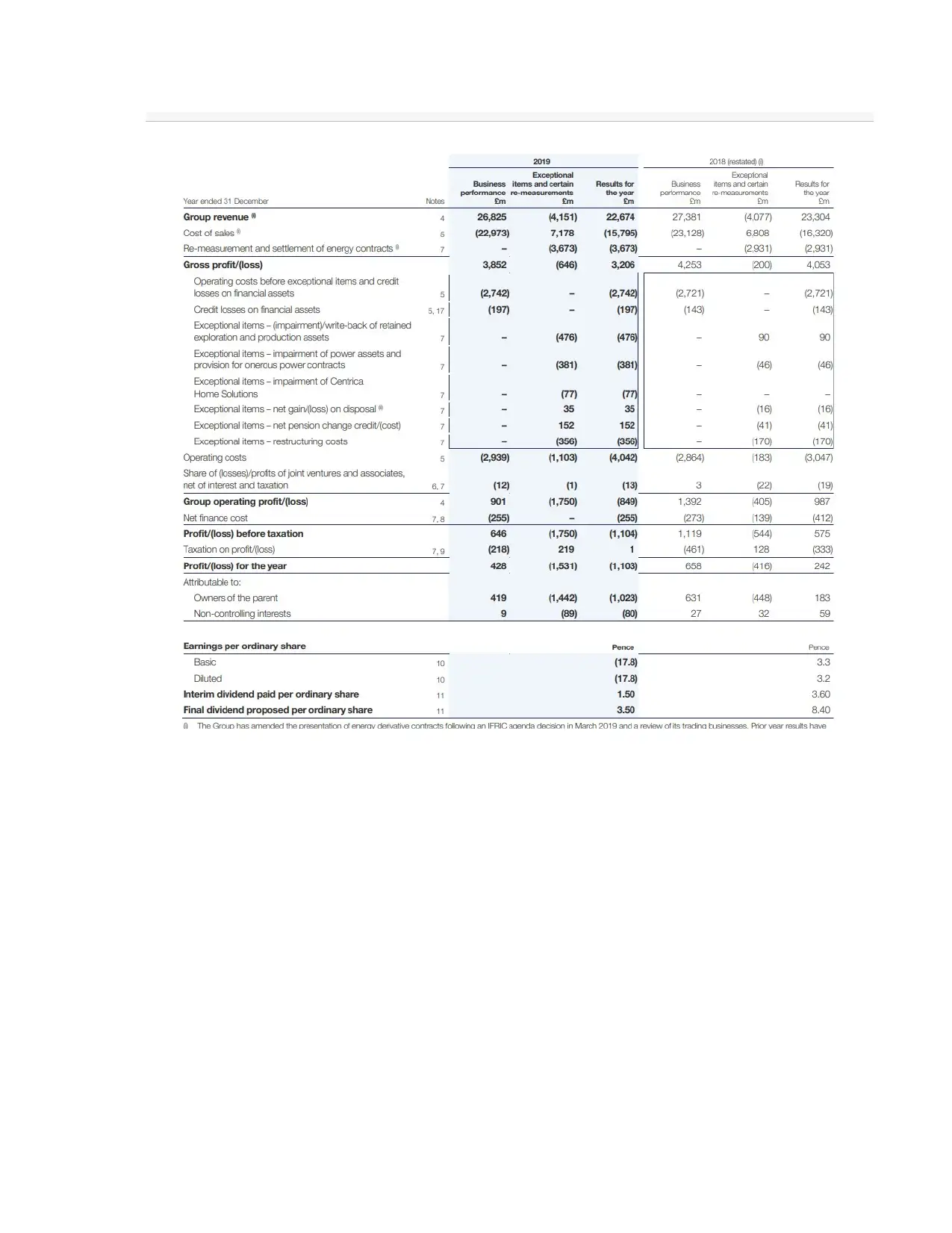
You're viewing a preview
Unlock full access by subscribing today!

1 out of 16
Related Documents
Your All-in-One AI-Powered Toolkit for Academic Success.
+13062052269
info@desklib.com
Available 24*7 on WhatsApp / Email
![[object Object]](/_next/static/media/star-bottom.7253800d.svg)
Unlock your academic potential
© 2024 | Zucol Services PVT LTD | All rights reserved.





